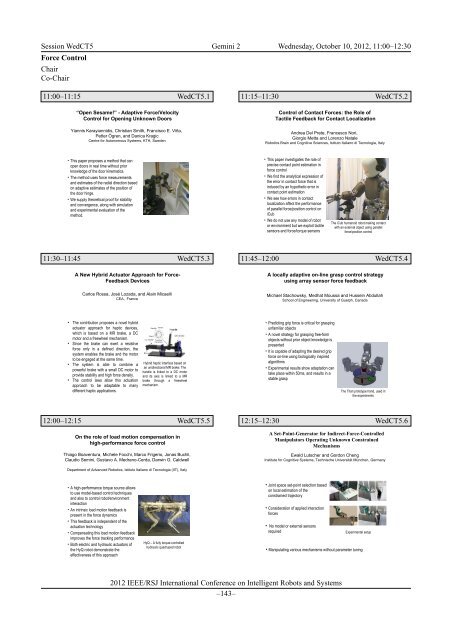Session WedAT1 Pegaso A Wednesday, October 10, 2012 ... - Lirmm
Session WedAT1 Pegaso A Wednesday, October 10, 2012 ... - Lirmm
Session WedAT1 Pegaso A Wednesday, October 10, 2012 ... - Lirmm
- TAGS
- pegaso
- october
- lirmm
- www2.lirmm.fr
You also want an ePaper? Increase the reach of your titles
YUMPU automatically turns print PDFs into web optimized ePapers that Google loves.
<strong>Session</strong> WedCT5 Gemini 2 <strong>Wednesday</strong>, <strong>October</strong> <strong>10</strong>, <strong>2012</strong>, 11:00–12:30<br />
Force Control<br />
Chair<br />
Co-Chair<br />
11:00–11:15 WedCT5.1<br />
“Open Sesame!” - Adaptive Force/Velocity<br />
Control for Opening Unknown Doors<br />
Yiannis Karayiannidis, Christian Smith, Francisco E. Viña,<br />
Petter Ögren, and Danica Kragic<br />
Centre for Autonomous Systems, KTH, Sweden<br />
• This paper proposes a method that can<br />
open doors in real time without prior<br />
knowledge of the door kinematics.<br />
• The method uses force measurements<br />
and estimates of the radial direction based<br />
on adaptive estimates of the position of<br />
the door hinge.<br />
• We supply theoretical proof for stability<br />
and convergence, along with simulation<br />
and experimental evaluation of the<br />
method.<br />
11:30–11:45 WedCT5.3<br />
A New Hybrid Actuator Approach for Force-<br />
Feedback Devices<br />
Carlos Rossa, José Lozada, and Alain Micaelli<br />
CEA, France<br />
• The contribution proposes a novel hybrid<br />
actuator approach for haptic devices,<br />
which is based on a MR brake, a DC<br />
motor and a freewheel mechanism.<br />
• Since the brake can exert a resistive<br />
force only in a defined direction, the<br />
system enables the brake and the motor<br />
to be engaged at the same time.<br />
• The system is able to combine a<br />
powerful brake with a small DC motor to<br />
provide stability and high force density.<br />
• The control laws allow this actuation<br />
approach to be adaptable to many<br />
different haptic applications.<br />
Hybrid haptic interface based on<br />
an unidirectional MR brake: The<br />
handle is linked to a DC motor<br />
and its axis is linked to a MR<br />
brake through a freewheel<br />
mechanism.<br />
12:00–12:15 WedCT5.5<br />
On the role of load motion compensation in<br />
high-performance force control<br />
Thiago Boaventura, Michele Focchi, Marco Frigerio, Jonas Buchli,<br />
Claudio Semini, Gustavo A. Medrano-Cerda, Darwin G. Caldwell<br />
Department of Advanced Robotics, Istituto Italiano di Tecnologia (IIT), Italy<br />
• A high-performance torque source allows<br />
to use model-based control techniques<br />
and also to control robot/environment<br />
interaction<br />
• An intrinsic load motion feedback is<br />
present in the force dynamics<br />
• This feedback is independent of the<br />
actuation technology<br />
• Compensating this load motion feedback<br />
improves the force tracking performance<br />
• Both electric and hydraulic actuators of<br />
the HyQ robot demonstrate the<br />
effectiveness of this approach<br />
HyQ – A fully torque-controlled<br />
hydraulic quadruped robot<br />
11:15–11:30 WedCT5.2<br />
Control of Contact Forces: the Role of<br />
Tactile Feedback for Contact Localization<br />
Andrea Del Prete, Francesco Nori,<br />
Giorgio Metta and Lorenzo Natale<br />
Robotics Brain and Cognitive Sciences, Istituto Italiano di Tecnologia, Italy<br />
• This paper investigates the role of<br />
precise contact point estimation in<br />
force control<br />
• We find the analytical expression of<br />
the error in contact force that is<br />
induced by an hypothetic error in<br />
contact point estimation<br />
• We see how errors in contact<br />
localization affect the performance<br />
of parallel force/position control on<br />
iCub<br />
• We do not use any model of robot<br />
or environment but we exploit tactile<br />
sensors and force/torque sensors<br />
<strong>2012</strong> IEEE/RSJ International Conference on Intelligent Robots and Systems<br />
–143–<br />
The iCub humanoid robot making contact<br />
with an external object using parallel<br />
force/position control<br />
11:45–12:00 WedCT5.4<br />
A locally adaptive on-line grasp control strategy<br />
using array sensor force feedback<br />
Michael Stachowsky, Medhat Moussa and Hussein Abdullah<br />
School of Engineering, University of Guelph, Canada<br />
• Predicting grip force is critical for grasping<br />
unfamiliar objects<br />
• A novel strategy for grasping free-form<br />
objects without prior object knowledge is<br />
presented<br />
• It is capable of adapting the desired grip<br />
force on-line using biologically inspired<br />
algorithms<br />
• Experimental results show adaptation can<br />
take place within 50ms, and results in a<br />
stable grasp<br />
The Titan prototype hand, used in<br />
the experiments<br />
12:15–12:30 WedCT5.6<br />
A Set-Point-Generator for Indirect-Force-Controlled<br />
Manipulators Operating Unknown Constrained<br />
Mechanisms<br />
Ewald Lutscher and Gordon Cheng<br />
Institute for Cognitive Systems, Technische Universität München, Germany<br />
� Joint space set-point selection based<br />
on local estimation of the<br />
constrained trajectory<br />
� Consideration of applied interaction<br />
forces<br />
� No model or external sensors<br />
required<br />
Experimental setup<br />
� Manipulating various mechanisms without parameter tuning

















